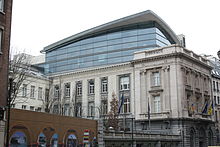Brussels Parliament building

The Brussels Parliament building is a neoclassical building located on Rue du Lombard/Lombardstraat in Brussels (Belgium) housing the Parliament of the Brussels-Capital Region.[1] It largely dates from the early 20th century, although some wings date back to the 17th century and certain later renovations.
Architecture
This section needs expansion. You can help by adding to it. (February 2008) |
The hemicycle is on the top floor of the building, with the roof being of modern zinc and glass design. The chamber is encircled by a long curved wooden wall and there is an overhanging press and public gallery. Committee rooms have likewise been updated with modern technology but much of the building remains neoclassical. There is also a cafeteria and reading room for deputies. The four rear wings have administrative functions, including housing the President's offices. There is also 400 m2 (4,300 sq ft) of hanging gardens extending to heights of up to 27 metres (89 feet).[1]
History
Towards the end of the 17th century, the site housed the vast mansion of the Maes family on Rue du Chêne/Eikstraat, which was destroyed in 1695 by Louis XIV during his bombardment of Brussels in the War of the Grand Alliance. The remains of the mansion and its lands were bought by the Count of Limminghe, Charles van den Berghe, who held numerous posts of administration in Brussels, being twice burgomaster of the city (later mayor). A year later, in 1696, he built another large, prestigious two-story mansion at the end of an enclosed courtyard with a garden (entered via Saint-Jean/Sint-Jan), which was then sold on to various figures such as Apostolic Nuncio and the then-ambassador to England.[1]
The building was acquired by the state for the first time in 1823 when the Brabant Province and the Dutch State bought it to house the Brabant government and act as the official residence of the local governor. This situation continued after the independence of Belgium in the 1830s. Due to development of the provincial government, however, the building became too small and dilapidated by the end of the 1860s. Hence there were successive waves of reconstruction, albeit with a planned design for consistency. The governors residence began to be modified in 1885, and in 1907 the office wing was replaced. Georges Hano, the then-architect for the Ministry of Public Works, built a higher wing with direct access to Rue de Chêne. The different buildings were also interlinked and the facades overlooking the courtyard were unified. The governors residence was increased one story on the side facing the courtyard and the height was also increased on the building surmounting the porch reconstructed by Hansotte. The new Rue du Lombard/Lombardstraat was opened up by the city at the start of the 20th century and Hano desired to make the presence of the provincial government felt on this new road which his complex now bordered. In 1913 works began on a new building, completed in 1930, in a neo-Louis XVI style with a ceremonial entrance hall and lavish decoration.[1]
In 1995, Brussels was split from Brabant and given its own regional government. The Federal government gave the building to the Brussels-Capital region who in turn gave it to the Brussels Regional Parliament, who were searching for a seat. However, it became apparent that the buildings were unsuited for the role of a Parliament, leading to the opening of an architectural competition later that year. The resulting changes made included increasing the height of the wing overlooking Rue du Lombard in order to erect a new hemicycle on the top floor. This added a large modern roof element to the neoclassical design of the building. Committee rooms were given modern equipment and state rooms were restored. Despite the renovation to the building, the original dimensions have been retained. A multipurpose hall was also built beneath a hanging garden to create a link between the different sections of the building.[1]
Art
Since being taken over by the Brussels Region, the building has hosted various modern works of art maintained by a commission who purchase the works for the Parliament. The Commission is composed of members of the Parliament Office together with eight external observers from the art world. In 1998, this commission entrusted 11 artists to create works for areas of the building;[1]
- Yasmina Assbane for the floral kerchiefs
- Rudy Bogaerts for the artistic area dedicated to the memory of famous personalities
- Patrick Corillon for the "Three stories of Oskar Serti".
- Paul Day for terracotta high-reliefs
- Wim Delvoye for the "Love letter from Mohammed to Caroline"
- Gilbert Fastenakens for the photos transferred to canvas
- Joseph Kosuth for the illuminated frieze
- Guy Leclercq for the re-mounted canvasses
- Michel Mouffe for a set of mirrors and illuminated blocks
- Richard Venlet for the drawings of the electrical installations
- Julien Willem for the Brussels portrait gallery
See also
- Brussels Parliament
- Belgian Federal Parliament (federal assembly - upper and lower houses)
- Flemish Parliament (regional and community assembly)
- Walloon Parliament (regional assembly)
- Parliament of the French Speaking Community (community assembly)
- Parliament of the German Speaking Community (community assembly)
- Commission communautaire française (COCOF)
- Vlaamse Gemeenschapscommissie (VGC)
References
- ^ a b c d e f Parliament building Archived October 16, 2007, at the Wayback Machine, Brussels Parliament website
